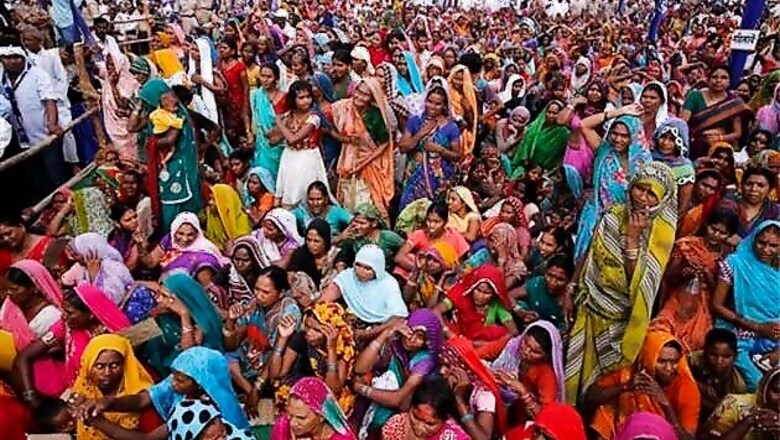
views
Like one of those professional wrestling cage matches, Elections 2014 has become a slugfest with more chaos, heat and dust than light. Also, just like a cage match, it is by now difficult to determine whether the vitriol and melodrama is real, feigned or well scripted. Score at half-time: Gandhi family against Modi; Modi and Co. against all comers; TMC calling Modi a butcher; Azam Khan rewriting the history of the Kargil war; Mulayam Singh effectively condoning rape; family soap opera in Tamil Nadu; real versus fake Punjabiyat; Pakistan visas for malcontents; toffees, balloons and headgear.
Whatever expectations observers and voters had of reasoned debate on the real issues affecting India have been utterly belied, as with earlier elections, as campaign season has progressed. At this rate, by the end of voting on May 12, the contenders will be looking around at the mess and wondering what the real issues were supposed to be anyway.
So we remind them of the urgent and real issues this country faces, the very basic everyday concerns that voters have, not the grand visions of progress and economic equality bandied about by all sides. We also apologise in advance to all the impassioned debaters on social media: theoretically, at least, reasoned political discourse is supposed to be on evidence and current ground realities, not rants.
Inflation: Remember the outcry of the last two years when prices of essential commodities shot through the roof? From food to petrol, price levels today stand several rungs higher than mere months earlier and show no signs of stabilising. We occasionally hear the RBI's Raghuram Rajan on what the Central Bank might do; what any of the numerous contenders to the new Cabinet might plan for this, however, remains a mystery. Even if macroeconomic indices are too abstract or 'dry' for voters on the ground, surely parties need to tell people specifically how food on the table will not be even more unaffordable over time?
Fiscal deficit: The long-term determiner of price levels, India's fiscal deficit has been galloping away uncontrolled in the past few Budgets. While both Congress and BJP manifestos have big ticket promises for the future, neither Congress' plans for several subsidized schemes, nor BJP's plans for mega construction projects will be good news for the fiscal deficit. Sadly, personal attacks make for cooler sound bytes.
Healthcare: You can get away with reducing your entertainment budget (if you have one). If, instead, you are part of India's overwhelming majority which doesn't have an entertainment budget, you might even cut corners on religious/traditional expenses, like weddings and funerals. But you can't cut down on medical expenditure if you fall sick. And with the way our quality of life suffers in urban and rural spaces, medical expenses take up increasing space in household budgets.
But India's public health structure, the only recourse for most citizens, is breaking apart at the seams. Despite years of social glory for youngsters choosing the medical profession, we have just one doctor per 1,700 citizens, far less than WHO's recommended minimum 1 per 1,100. In the last two decades, India has earned the ignominy of being one among only three developing countries whose Hunger Index, including children's malnutrition, has actually gone up (even Pakistan and Bangladesh have managed to reduce it somewhat). Even if government hospitals increase their intake capacity for patients, getting quality manpower and reliable, non-adulterated medicines will continue to dog the country, as will nutrition for children.
Urban infrastructure: While various surveys point to the rising numbers of India's middle classes, here's a figure that hasn't been mentioned lately: within the next two decades, urban India will be on the verge of outnumbering rural India, and might even do it by the middle of this century, just about when we become the world's most populous country. Increasingly dense urban clusters will compete for limited facilities, such as water and power. Urban infrastructure is already under pressure and in some areas has ceased to function. Unless one wants to see increasingly violent competition for limited resources, urban India needs to be restructured urgently. The longer this process takes, the more difficult it will be to bridge the gap between infrastructure and demand for it. A few satellite towns or transport systems will be like the proverbial little Dutch boy with his finger in a hole in the dike. Difference is, the boy had to do it for just a single night.
Security: We are not talking big-ticket security matters here. Rhetoric notwithstanding, it will be a while yet before India has a literal dozen aircraft carriers in the world's oceans enforcing our writ across continents, or stealth helicopters hugging the treeline on their way to take out Hafeez Saeed. We're talking of security at a personal, everyday level. Our cities, with an increasing floating population, are also breeding grounds for crime waves of increasing intensity, which in turn feed parochial politics. While the middle class and gated communities retreat further within themselves, vast stretches of the cities become unsafe for everyone else.
Our villages are either grossly unpoliced or ruled with colonial-era iron fists by law enforcement. Indian citizens' relationship with law enforcement has always veered between utter anarchy and virtual police states, and space for law-abiding citizens is gradually being ceded to every variety of maniac. At a personal, individual level, this is as much a matter of distress as national security matters.
Gender Equality: The debate about violence against women has now devolved, very conveniently for political parties, into law enforcement and sexual assault. While crimes against women are related to the state of policing, it is also symptomatic of deeper problems within society, starting from women's education and equal opportunities in every sphere. These are as much within the ambit of our lawmakers as the police and courts. And yet barring a few words like empowerment, we are unlikely to hear concrete proposals on these issues, which straddle the gulf between society and law.
Education: Even as the new middle class clamours for higher growth and more economic opportunities, what is being missed in the development debate is the quality of manpower being churned out. Mere availability of jobs and human resource in bulk is not enough. Consider the much-vaunted BPO sector. The Philippines today brings in more revenue from BPOs than we do and is likely to widen the gap as time passes. The quality of manpower in both manufacturing and services even a few years ago in India was admirable, but has plummeted lately, because demand has outstripped quality manpower. Job-oriented training today is limited to the minimum needed for jobs and not much more.
In academics, while primary education has expanded, higher education, despite being more easily accessible than even in Western countries, has not improved qualitatively. Succeeding administrations have been curiously unable to encourage quality in middle and higher education levels. As pressure on resources mounts, manpower quality will continue to plummet, taking the growth rate, inevitably, with it. And yet there is silence on these specifics.
Pollution: An obvious objection to this point would be, in a country where the basics are not being provided for and disparities mounting, can we really afford to be tree-hugging green activists? This is missing the larger picture. With our density of population and limited options, every form of pollution becomes an instant, long-term hazard, affecting the water we drink, the food we eat and the air we breathe. It has now become more than a mere passing fad to be occasionally encouraged. Official positions on pollution are equally to blame for their inability to focus on relevant areas.
Consider our rivers. In the CAG's audit of water pollution across the country, the report mentions that the capacity of sewage treatment plants was higher than the amount of sewage flowing into some rivers, good news for local residents. However, in the same report, the amount of dissolved oxygen per litre in these rivers was found to be zero, meaning it was not possible for aquatic life to survive in a river despite almost no sewage flowing into it, partly because of other untreated effluents. A situation where the mere treatment of sewage is considered enough to preserve the health of our rivers can't stop water problems in the future across the country. Once again: no one seems to have noticed. And the toxic air of most urban agglomerations doesn't even merit a mention.
The hinterland: We shall not mention here how the media has abrogated its responsibility for national reportage, limited itself to the metros. In election season, the Northeast, with a meager two dozen MPs across seven states, or J&K with six, might not count for much, so one can understand if the issues here get drowned in national-level rhetoric. But across the Indian heartland is the Red Corridor, the massive swathe of land from Bihar to Andhra, with nearly a hundred constituencies where economic and social factors have given rise to Maoism. The region is also resource-rich, but has never really got its due following Independence. If these issues were discussed, or even tackled, by the parties, both at a local and national level, it would go a long way in assuring the voters here that a new government will treat this as a humanitarian, and not merely a law-and-order problem. Barring local candidates, however, India's marginalised heartland hasn't found its way into any campaign talk, and is not likely to.















Comments
0 comment